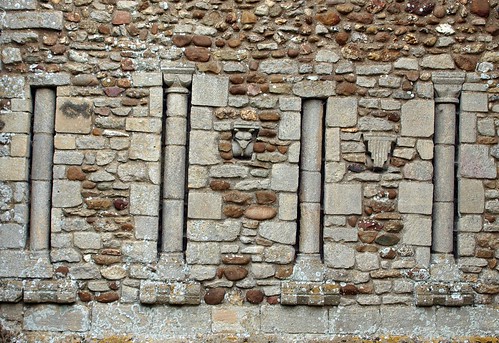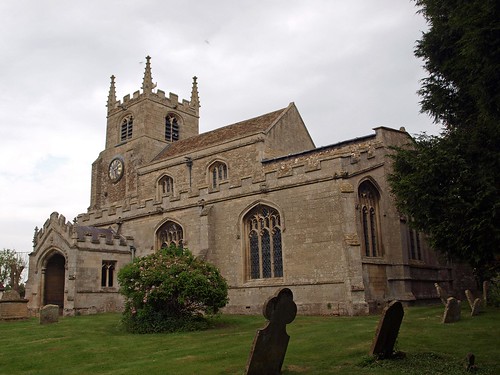Anyway I decided to swallow my pride and found the keyholder out.
It's a gem of a building with some fabulous corbels. gargoyles and grotesques.
ST MARTIN. The most interesting thing about the church is that R. Hutchinson, who restored it, collected earlier remains carefully and displayed them to advantage. Thus in the S wall of the tower outside are Norman column-shafts, and inside the tower whole collections including an arch with proper beakhead, an arch with beakhead stylized to excess (cf. Spaldwick), two Norman window-heads, and lengths of a battlement frieze and billet, in the N aisle N wall outside quite a length of Norman corbel-table, and in the N chapel S arch a whole order of short Norman rolls or tubes set at r. angles to the arch. Something similar seems to have been done by Hutchinson inside the nave, where carved friezes of Early Renaissance foliage are used to form a vertical strip (N), a cross (S), and a square set in a lozenge (E). Due to Hutchinson may possibly also be the wealth of corbels. A large winged man is attached to the N arcade, and there are plenty of smaller ones. Now for the church itself. The W tower is short and has big pinnacles but no spire. There is a top quatrefoil frieze. Perp windows in the S and N aisles, the clerestory, and the chancel (E). The S porch has the date 1652, but it is Perp, and the S doorway inside is quite ornate, with the stoup in a niche on the r. and a bracket on the l. The two-bay arcades of standard elements are Perp also. The SE respond is a monster devouring a man, the deed performed horizontally. The chancel arch and the one-bay N and S chapels are contemporary with the arcades. - FONT. Octagonal, with quatrefoils. Leaves on the underside. - GUERIDON. By the altar. Domestic, and probably of c.1730-40. - STAINED GLASS. In the S chapel parts of canopies made up as canopies.
LITTLE STUKELEY. Eight centuries have helped to give this village its chief treasure. It is in a hollow near Ermine Street, a church the Normans began with old Henry of Huntingdon watching them at their work.
He was born hereabouts soon after the Conqueror came, and he wrote a History of England from Roman times to the death of King Stephen in 1154, carrying on the work of Bede and other chroniclers. He was Archdeacon of Huntingdon for nearly half of the 12th century, and it is believed he built this church at Little Stukeley. It may have been his birthplace, but at any rate we may feel that many times this scholar would leave his books and his writing and walk over to see the Norman masons at their work. It has been much changed, but fragments of the west wall and ornamental stones on an arch in the north wall of the chancel are still as he would see them. Part of the tower is 13th century, part of the chancel 14th.
In the nave above the piers are interesting carved stones of the 16th century, among them some angels, a ram, and a curious bearded man in pleated gown and wearing a tall brimmed hat. There is a stoup with a lion’s head and an angel fading away, a Jacobean altar table, some ironwork 400 years old in windows, a 15th century font bowl carved with flowers, and a little glass painted about the time our first books were printed. A brass shows Sir Nicholas Stukeley in his Tudor cap and gown. The village remembers a martyr of the 19th century, Flora Lucy Stewart, who was brought up at the rectory and lost her life in a violent outburst of superstition in China in 1893.
He was born hereabouts soon after the Conqueror came, and he wrote a History of England from Roman times to the death of King Stephen in 1154, carrying on the work of Bede and other chroniclers. He was Archdeacon of Huntingdon for nearly half of the 12th century, and it is believed he built this church at Little Stukeley. It may have been his birthplace, but at any rate we may feel that many times this scholar would leave his books and his writing and walk over to see the Norman masons at their work. It has been much changed, but fragments of the west wall and ornamental stones on an arch in the north wall of the chancel are still as he would see them. Part of the tower is 13th century, part of the chancel 14th.
In the nave above the piers are interesting carved stones of the 16th century, among them some angels, a ram, and a curious bearded man in pleated gown and wearing a tall brimmed hat. There is a stoup with a lion’s head and an angel fading away, a Jacobean altar table, some ironwork 400 years old in windows, a 15th century font bowl carved with flowers, and a little glass painted about the time our first books were printed. A brass shows Sir Nicholas Stukeley in his Tudor cap and gown. The village remembers a martyr of the 19th century, Flora Lucy Stewart, who was brought up at the rectory and lost her life in a violent outburst of superstition in China in 1893.



No comments:
Post a Comment